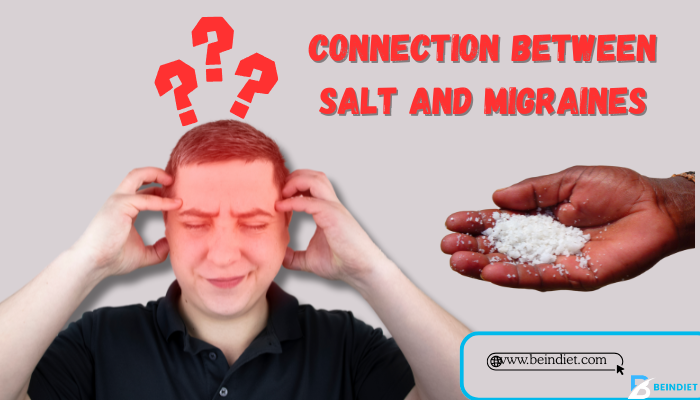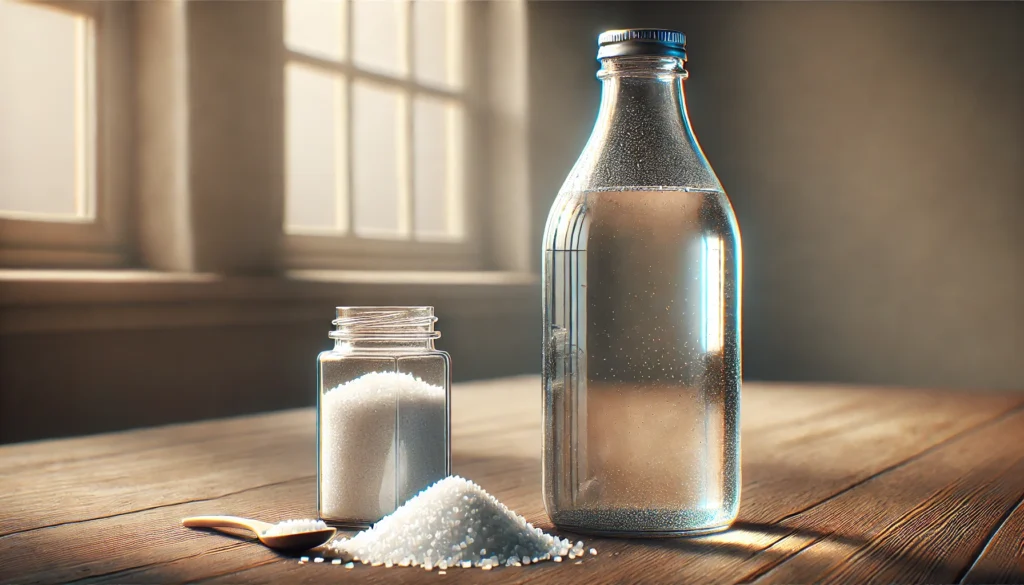Migraines affect millions of people worldwide. They can cause severe pain and disrupt daily life. Most people use prescription medications for treatment, but many also look for natural remedies. One option is using salt for migraines. Some people believe that Himalayan rock salt or Celtic sea salt can help by rehydrating the body and balancing electrolytes, which may lessen migraine symptoms.
Let’s explore the benefits and risks of using salt for migraines, and provide practical tips on how to use it safely, with a real-life example
What Is the Connection Between Salt and Migraines?

A combination of factors, including dehydration, electrolyte imbalances, and low blood pressure, often triggers migraines. Salt plays a vital role in regulating the body’s fluid balance, supporting nerve function, and ensuring overall hydration. During episodes of dehydration, particularly when experiencing a migraine attack, drinking salt water can be a beneficial remedy. Also, it helps to replenish essential electrolytes and fluids that may have been lost, providing relief and restoring the body’s necessary balance during these challenging times.
While there is limited scientific research on the direct effects of salt on migraines, anecdotal reports suggest that certain types of salt, like Celtic salt may help relieve symptoms.
Case Study: Jane’s Experience with Himalayan Salt for Migraines
Jane, a 34-year-old teacher from Texas, suffered from chronic migraines for over five years. Despite trying various prescription medications, she found little relief. After reading about pink Himalayan salt for migraines, Jane decided to try it as a complementary remedy.
During an attack, Jane mixed half a teaspoon of Himalayan rock salt for migraines in an 8-ounce glass of water and sipped it slowly. After that, within 30 minutes, she noticed that her nausea had subsided and the intensity of her headache had reduced. Encouraged by these results, Jane included small amounts of Celtic sea salt for migraines in her daily diet to maintain her electrolyte balance.
While she acknowledged that this remedy did not completely eliminate her migraines, it helped manage her symptoms when used alongside other treatments. Jane’s case underscores the potential benefits of using salt for migraine management while highlighting the importance of consulting a healthcare provider before trying new remedies.
Types of Salt Used for Migraines
- Celtic Salt for Migraines
Rich in trace minerals like magnesium and potassium, Celtic salt for migraines is often used to balance electrolytes and reduce dehydration-related symptoms. - Himalayan Rock Salt for Migraines
Himalayan salt contains over 80 trace minerals and is believed to help with hydration and mineral restoration. It’s commonly used in remedies like salt water for migraines or added to food. - Sea Salt for Migraines
Sea salt, which contains natural minerals, is another popular option. Mixing it with water to create salt water for migraines is a quick way to restore hydration. - Epsom Salt for Migraine Headaches
Epsom salt is made of magnesium sulfate and is used in baths, not taken as food. An Epsom salt bath can help relieve migraine headaches by relaxing muscles and reducing tension related to migraines.
How to Use Salt for Migraine Relief
- Drinking Salt Water for Migraines
To use salt water for migraines, dissolve a pinch of salt (about ¼ to ½ teaspoon) in a glass of water. Sipping this mixture slowly during a migraine attack may help you alleviate symptoms by replenishing electrolytes and improving hydration. - Using Epsom Salt for Migraine Headaches
Epsom salt baths can be particularly helpful for tension-type migraines. Add 1-2 cups of Epsom salt to a warm bath and soak for 20-30 minutes to relax muscles and reduce your headache intensity. - How Much Salt Water for Migraines?
The amount of salt to use depends on individual needs. Start with a small amount, such as ¼ teaspoon of salt, mixed in a glass of water. Avoid consuming excessive amounts of salt, which can lead your dehydration or other health issues.
Potential Benefits of Salt for Migraines
- Electrolyte Replenishment
Certain salts, like Celtic salt or Himalayan salt, contain essential minerals like magnesium and potassium, which are critical for your nerve function and hydration. - Improved Hydration
Combining salt with water can enhance your body’s ability to retain fluids, which may help reduce migraines caused by dehydration. - Natural and Accessible
Salt is an affordable and widely available remedy; you can make it an attractive option for those seeking natural solutions for migraines.
Risks and Precautions
- Excessive Salt Consumption
Consuming too much salt, even beneficial varieties like pink Himalayan salt for migraines, can cause high blood pressure, dehydration, and kidney problems. - Not a Cure-All
Salt may help manage migraines caused by dehydration or electrolyte imbalances, but it is not a cure. If you have chronic or severe migraines, see a healthcare provider for diagnosis and treatment. - Allergic Reactions or Sensitivities
Some individuals may rarely experience negative reactions to specific types of salt. Always start with small amounts to ensure compatibility.
Alternatives to Salt for Migraine Relief
- Magnesium-Rich Foods
Foods like dark leafy greens, almonds, and blueberries, which are rich in magnesium, may help you reduce the frequency and severity of migraines. - Cell Salts for Headaches
Homeopathic remedies like cell salts are another option some people explore to manage headache symptoms. - Proper Hydration
Plain water or electrolyte drinks can often be just as effective as salt water for migraines in preventing dehydration-related headaches. - Epsom Salt Baths
Non-oral remedies like an Epsom salt bath for migraine headaches can relax muscles and reduce stress.
At the End

Using salt for migraines is a simple and potentially effective remedy for managing dehydration-related headaches. Remedies like drinking salt water or soaking in an Epsom salt bath can provide temporary relief for some people with headaches. However, it’s important to use salt in moderation and see a doctor if your migraines continue.
Use salt-based remedies as part of a complete plan to manage migraines. This plan should include drinking enough water, eating a balanced diet, and following medical treatments that fit your needs.
Written by
Sarah Miller, Health and Wellness Advocate
Top 10 Vegan Breakfast Recipes
What are the benefits of using salt for migraines?
Certain salts replenish electrolytes, providing essential minerals like magnesium and potassium. They also enhance hydration by helping the body retain fluids. Plus, salt is natural, widely available, and affordable.
Are there alternatives to using salt for migraine relief?
Yes, the blog post mentions several alternatives:
Magnesium-rich foods
Cell salts for headaches
Proper hydration with plain water or electrolyte drinks
Epsom salt baths
Does Salt Water Fix Headaches?
Saltwater can help migraines caused by dehydration or low electrolyte levels, but it’s not a guaranteed fix. Since migraines have various triggers, salt remedies work best for specific issues like electrolyte imbalances.
Should I consult a doctor before trying salt for migraines?
It’s important to consult a healthcare provider before trying new migraine remedies, especially if you have chronic migraines or other health issues. They can provide a tailored diagnosis and treatment plan.







[…] Click this related article… […]
I was recommended this website through my cousin. I am no longer certain whether this post is written by way of him as nobody else understand such distinct approximately my trouble. You’re amazing! Thank you!
My pleasure. And thanks for your comment.
Kantorbola99 menawarkan pengalaman bermain slot online yang menyenangkan. Platform ini menyediakan beragam pilihan game menarik. Pemain dapat menikmati tampilan grafis berkualitas tinggi.
Kantorbola merupakan pilihan terbaik bagi para penggemar slot online di Indonesia. Dengan berbagai permainan menarik, bonus melimpah, keamanan terjamin, dan layanan pelanggan yang unggul.
Daftar dan login ke Kantorbola versi terbaru untuk pengalaman bermain bola online terbaik. Ikuti panduan lengkap kami untuk akses mudah, fitur unggulan, dan keamanan terjamin.
Thanks for your comment. Can you try your comment as an English language please.
Thank you for the sensible critique. Me & my neighbor were just preparing to do some research about this. We got a grab a book from our area library but I think I learned more clear from this post. I am very glad to see such wonderful information being shared freely out there.
My pleasure.
It’s truly a nice and useful piece of info. I am glad that you simply shared this useful info with us. Please keep us up to date like this. Thanks for sharing.
My Pleasure.
Pretty section of content. I just stumbled upon your blog and in accession capital to assert that I get in fact enjoyed account your blog posts. Anyway I’ll be subscribing to your feeds and even I achievement you access consistently quickly.
I truly value your piece of work, Great post.
Wow! This blog looks exactly like my old one! It’s on a completely different subject but it has pretty much the same page layout and design. Wonderful choice of colors!
Interesting blog! Is your theme custom made or did you download it from somewhere? A design like yours with a few simple adjustements would really make my blog jump out. Please let me know where you got your theme. With thanks
I think this web site contains some very great info for everyone : D.
Thanks.
Absolutely indited content, regards for information. “In the fight between you and the world, back the world.” by Frank Zappa.
Thank you very much.
I like this website its a master peace ! Glad I discovered this on google .
Thanks.
Some genuinely good information, Gladiola I observed this. “If you don’t make mistakes, you aren’t really trying.” by Coleman Hawking.
he blog was how do i say it… relevant, finally something that helped me. Thanks
Hi my friend! I wish to say that this post is awesome, great written and include almost all significant infos. I would like to see extra posts like this .
I want gathering useful information , this post has got me even more info! .
hello!,I really like your writing very a lot! percentage we be in contact more about your post on AOL? I require an expert in this space to solve my problem. Maybe that’s you! Having a look ahead to see you.
I’ll right away take hold of your rss as I can’t find your email subscription hyperlink or newsletter service. Do you have any? Kindly let me know so that I may just subscribe. Thanks.
I will immediately take hold of your rss as I can’t to find your email subscription link or newsletter service. Do you’ve any? Please allow me realize so that I could subscribe. Thanks.
Thank you for sharing with us, I believe this website really stands out : D.
You’re welcome
I was very pleased to find this web-site.I wanted to thanks for your time for this wonderful read!! I definitely enjoying every little bit of it and I have you bookmarked to check out new stuff you blog post.
Hello this is somewhat of off topic but I was wondering if blogs use WYSIWYG editors or if you have to manually code with HTML. I’m starting a blog soon but have no coding experience so I wanted to get guidance from someone with experience. Any help would be greatly appreciated!
Thanks for your comment, if you need any for web blog please contact our web developer
alaminn8m123@gmail.com